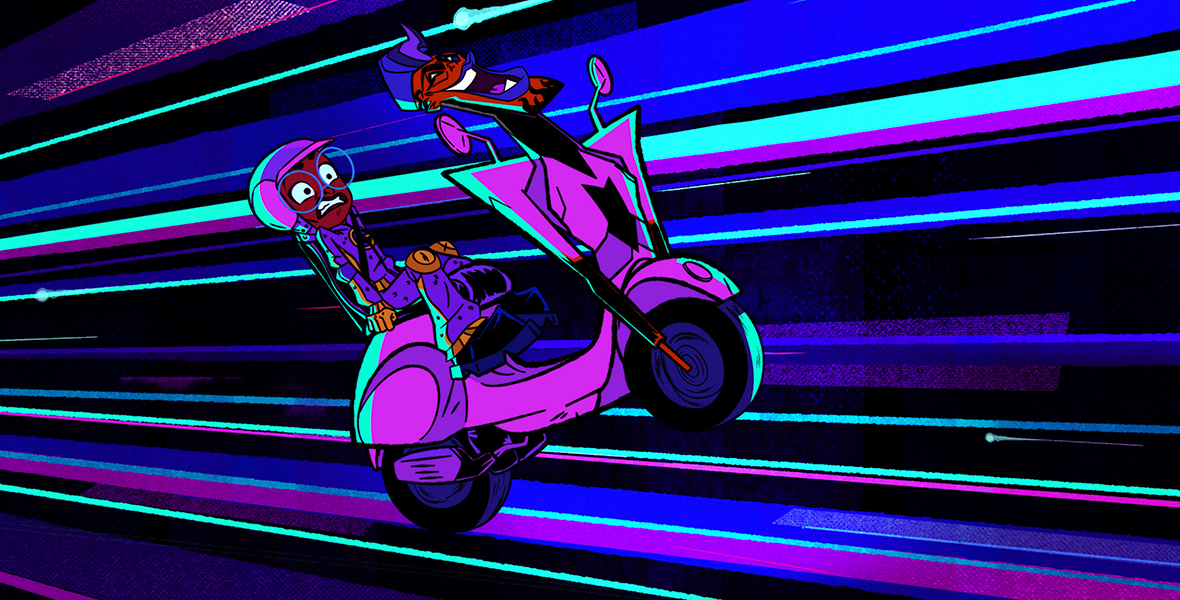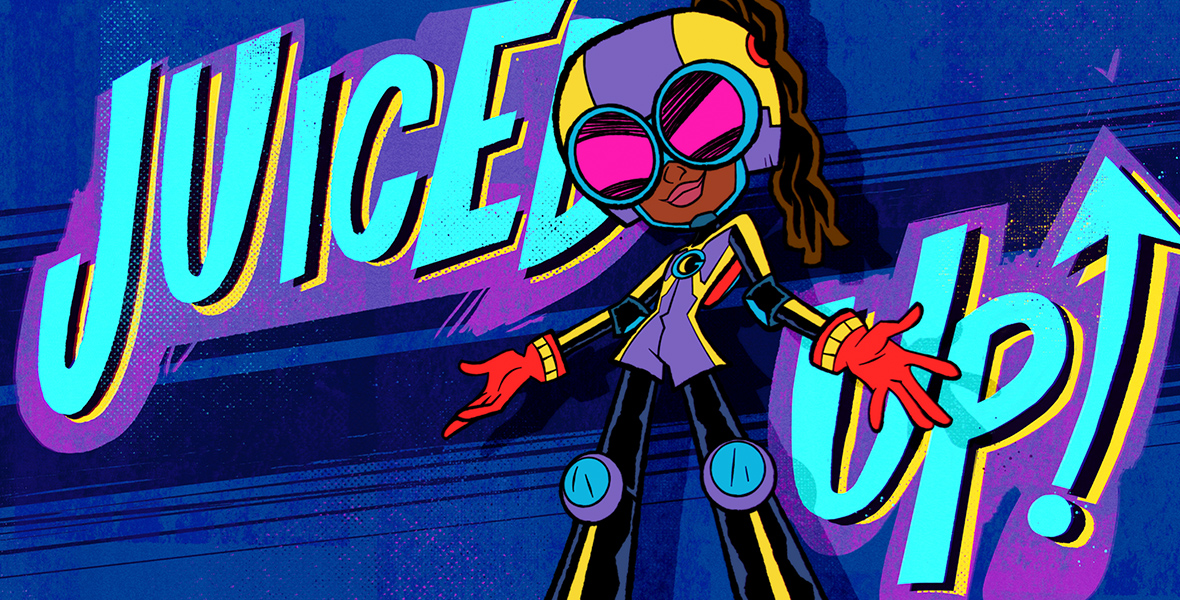By Cecilia Sarantopoulos
Lunella Lafayette is no ordinary 13-year-old. In Season 1 of Marvel’s Moon Girl and Devil Dinosaur, Lunella, part-time Super Hero and science aficionado with perfect grades, emerged as the savior of New York City’s Lower East Side, fending off various enemies with her partner, Devil Dinosaur. While she maintains close ties with her family, only one family member knows her secret identity, knowledge that led to revelations unearthing Lunella’s past and the origins of her Super Hero persona.
Coming February 2 to Disney Channel and Disney XD—with episodes appearing the next day on Disney+—Season 2 of Marvel’s Moon Girl and Devil Dinosaur plunges viewers into uncharted territory, exploring a captivating mix of secrets, history, and new adversaries. This animated series not only boasts an engaging storyline but also captivates viewers with its exceptional music and vibrant graphic design.
D23 was lucky enough to speak with executive producer Steve Loter and co-executive producer Rodney Clouden about Lunella’s new adventures. (Warning: This article includes spoilers for Season 1 of Moon Girl and Devil Dinosaur.)
D23: The Official Disney Fan Club: Season 1 ended on an absolute cliffhanger. What can you tell us about what viewers can expect from Season 2?
Steve Loter (SL): Season 2 is a roller coaster. Lunella is dealing with a lot. She’s dealing with the fact that she is now an established Super Hero. So, villains are leveling up against her. She has this inner conflict, trying to manage life with her family and life as a Super Hero patrolling the streets. Even her friendships are strained. You could say that it’s a big growth season, but you know what? There’s still plenty of music and comedy too.
D23: Speaking of music, how does the team select songs for this series? It’s such an important aspect of the show. What do you hope the audience will gain from the amazing soundtrack you’ve chosen?
Rodney Clouden (RC): We wanted to continue what Season 1 gave the audience but to also step it up a little bit to help propel the storytelling. The soundtrack was something that we wanted to level up. One of the songs in the first episode of Season 2 is “Juice It Up.” We filled in the driving beat of the song and wanted to take the audience on an emotional journey.

D23: Color is also a crucial aspect of the show. Could you elaborate on how you’re leveling up the color in Season 2 and how it contributes to the show’s storytelling?
SL: Chris Whittier, Jose Lopez, and our amazing art team are just absolutely incredible. We treat each episode as a mini movie. We do color scripts and a lot of different palettes, color changes, and shifts depending on mood and tone of the scene. It’s very theatrical. We want to ensure that everything feels like an experience on its own when you’re watching the episode.
RC: Yes. It’s not just color for the sake of color. There is a reason why each color exists; it sets a mood, emotion, or tone for that particular scene. So, it’s not just like “Oh, it’s dark.” It’s green, moody, bright, or sunny for a specific reason. There’s a lot of effort that’s put into it and into the storytelling arc and movement of each scene.
D23: One of my favorite aspects of the show is Lunella and Casey’s partnership. Can you give fans a bit of insight into how you decided to develop this duo, and how each character complements the other?
SL: Casey is a perfect best friend for Lunella because they’re so different and they complement each other. Lunella started out being somewhat introverted at the top of Season 1, and Casey’s very extroverted, but together they form the perfect version of each other as friends. As Season 2 goes on, we introduce some new characters to that friendship circle. Kid Kree in particular is a really great character. We have a Super Hero team-up too with a character named Turbo. So, it’s interesting to see the friendship dynamic that comes through in this circle.
D23: How do Devil Dinosaur’s personality, strengths, and weaknesses complement Lunella’s?
RC: Well, you know what they say: “Opposites attract.” Lunella and Devil Dinosaur also work in tandem because they have this sort of “mind meld,” as you saw in the first season. They are in tune because they’ve learned what the other person needs and how the other person is going to react, and they know what they must do to support each other.
D23: Going back to cliffhangers, it was also revealed in Season 1 that Lunella’s grandmother, Mimi, whom Lunella grew up idolizing, is the original Moon Girl. How does this plot twist inform Season 2 and what can fans expect from this storyline?
SL: It has some big impacts. I mean, the difference is that, now, there’s two people holding a big secret in the Lafayette family, and the double lives are starting to collide. On the positive side, I think it’s great for Lunella to have someone that she can talk to about Super Hero life, and Mimi is an incredible scientist. They’re going to do some amazing stuff together not just technologically, but also emotionally.
D23: I love how the show celebrates women in STEM. How did you approach this specific topic in Season 2?
RC: I think it’s a continuous process. Lunella herself, a Black girl who is into STEM, is someone you don’t often see in the media. We wanted to lean into that, but also to give big props to the female scientists that exist in the world. So, we referenced, for example, Gladys West, who invented [models that led to the development of] GPS. We throw those [names] in every now and then to maybe prompt the audience to Google them and wonder, “Who is this person the show is referring to?” We also wanted Lunella to be an aspirational character who is relatable—someone who is doing great things in STEM and in her regular life.

D23: One of my favorite episodes of Season 1 was “Skip This Ad…olescence,” where Lunella uses gadgets to bypass all her chores. How do you balance the typical struggles that a teenager goes through with the scientific battles that Lunella specifically experiences?
SL: Every time we approach a story, we approach it by asking, “What is the relatable human emotion here?” That episode is about impatience. After we’ve done that, we pull in the technology or the mythology or the science-fiction nature of what it means to tell that story. The thing is, those types of stories have been told over and over again, so it’s up to you to clothe it in a way that is authentic. You want to be able to tell that story … in a way that it becomes complementary to the storytelling. You want to maintain that you’re telling a very relatable human story.
RC: For this show, it was also important to tell these stories in a way that is visually interesting and comedic, which is not how you’d typically come across these stories.
D23: In Season 1, Casey boosted Lunella’s confidence and urged her to just have fun. Is there a specific aspect of their relationship that Season 2 focuses on?
SL: Oh, absolutely. In Season 1, with Lunella being an introvert and Casey being an extrovert, they made a perfect pairing. In Season 2, their friendship grows and gets stronger, but it’s also strained at certain points in time. In particular, Casey becomes more involved in Lunella’s “Super Hero-ing” world. There’s an episode where Casey redoes Lunella’s lab in Casey fashion, which is not Lunella’s style. The friendship comes to a head at certain points, but, at the end, they’re still really great for each other. They love each other very much, so they’ll always see through the conflict. We wanted to show conflict but also resolution, because that’s relatable. I think it’s useful for our audience to be able to see how you can grow from an experience.
RC: Exactly. Female friendship is an important aspect of the show, and showing the ups and downs of it is something we wanted to include. It was important to emphasize how the two characters talk to each other, how they express themselves, how they feel, and how there’s a way to make things up and resolve conflict.
D23: Black identity is such an important part of the series. How did the creative team approach celebrating Black identity, and how have young fans responded to this aspect of the series?
RC: I’m not really on social media that much, but from what I’ve seen, people love to see themselves represented. They love thinking that on the show, there’s someone who reminds them of their cousin, to think, “Oh, that person looks just like me.”


